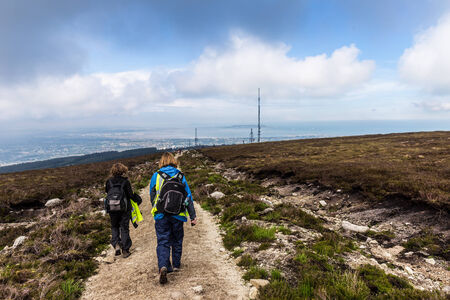Introduction to British Mammals
The British countryside is a treasure trove of wildlife, and among its most captivating residents are the mammals that roam its fields, woodlands, and moors. From the majestic red deer grazing in Scottish glens to the clever foxes darting through suburban gardens, the UK is home to an incredible variety of furry creatures. Whether you’re a seasoned rambler or heading out for a family stroll, spotting these mammals can turn any walk into a true adventure. Britain’s unique blend of wild spaces and rural landscapes offers countless opportunities to observe animals in their natural habitats. Join us as we explore what makes Britain’s mammal population so special—and how you can spot them on your next countryside trail.
2. Where to Spot Wildlife: Top Trails Across the UK
Britain is a treasure trove for wildlife enthusiasts, with its diverse landscapes offering countless opportunities to spot fascinating mammals in their natural habitats. Whether you fancy a gentle family stroll or an adventurous hike, there’s a trail just waiting to reveal its furry residents. Here are some of the best walking and hiking trails across the UK where you’re most likely to encounter red deer, foxes, badgers, and more.
Top National Parks for Mammal Spotting
| National Park | Mammals to Spot | Recommended Trails |
|---|---|---|
| New Forest | Ponies, red deer, fallow deer, foxes | Lyndhurst Circular Walk, Blackwater Arboretum Trail |
| Cairngorms | Red squirrels, pine martens, mountain hares | Rothiemurchus Forest Walk, Glenmore Forest Park |
| Lake District | Red deer, otters, badgers | Ennerdale Valley Trail, Grizedale Forest Walks |
| Exmoor | Exmoor ponies, red deer, bats | Dunkery Beacon Hike, Tarr Steps Circular Walk |
Local Hotspots Worth Exploring
- Richmond Park (London): Home to large herds of fallow and red deer – a wonderful spot for families who want to observe these majestic animals up close.
- Epping Forest (Essex): Ideal for glimpsing foxes and badgers during early mornings or dusk walks.
- The Brecon Beacons (Wales): Look out for elusive otters along riverbanks and keep an eye on open moorlands for wild ponies.
Family Tips for Wildlife Walks
- Early mornings or evenings are best for spotting mammals as they tend to be more active at these times.
- Bring binoculars and a notebook so children can record their sightings and learn about different species together.
A Little Local Wisdom
If you’re visiting a new area, pop into a local visitor centre or chat with rangers—they often know where recent sightings have occurred and can point you towards quieter paths where wildlife is less disturbed. So lace up your boots, grab your wellies if it’s muddy, and set off for a British wildlife adventure that every member of the family can enjoy!

3. Red Deer and Roe Deer: The Majestic Wanderers
When strolling along Britain’s countryside trails, the sight of a deer quietly grazing or darting through the woods can be a magical moment. Among the most commonly spotted species are the impressive red deer and the smaller, graceful roe deer. Red deer are Britain’s largest land mammals and are often found in the Scottish Highlands, though you may also encounter them in parts of England such as Exmoor and the Lake District. Roe deer, on the other hand, prefer woodland edges and farmland across much of England and Scotland, blending beautifully into their surroundings.
Observing these majestic creatures requires patience and respect for their space. Early mornings or late evenings are often the best times to spot deer, as they tend to be more active during these quieter hours. Move slowly and keep noise to a minimum—deer are naturally cautious and will quickly disappear at the slightest sign of disturbance. Binoculars are handy for getting a closer look without getting too close. Always stick to marked paths to avoid disturbing their habitats, especially during fawning season in late spring and early summer when young deer are particularly vulnerable.
If youre out with children, turn spotting into a gentle game—look for tracks, nibbled leaves, or listen for rustling in the undergrowth. Remember, appreciating these beautiful animals from a respectful distance not only keeps them safe but also ensures that future walkers can enjoy these magical encounters as well.
4. Clever Foxes and Other Nocturnal Neighbours
When the sun sets over the British countryside, a whole new cast of characters takes centre stage. Some of our most beloved mammals—like foxes, badgers, and hedgehogs—are masters of the night. These nocturnal neighbours are rarely seen during the day, but with a little patience and know-how, you can spot them safely and respectfully while out on British trails.
Meet Britain’s Nighttime Mammals
| Mammal | Key Features | Where to Spot | Best Time |
|---|---|---|---|
| Red Fox | Rusty-red fur, bushy tail, clever and adaptable | Woodlands, fields, even urban parks | Dusk or after dark |
| Badger | Black-and-white striped face, sturdy build, shy | Hedgerows, ancient woodlands | Late evening to early morning |
| Hedgehog | Tiny spines, round body, snuffling nose | Gardens, grass verges, woodland edges | Dusk through nightfall (spring to autumn) |
| Pipistrelle Bat | Tiny size, fluttering flight, insect-eater | Near water, woodland edges, churchyards | Just after sunset |
How to Spot Nocturnal Mammals Safely
- Be Quiet and Patient: Move slowly and keep noise to a minimum. Many nocturnal animals are easily startled.
- Use a Red Torch: A torch with a red filter helps you see without disturbing wildlife or ruining your night vision.
- Avoid Direct Contact: Never try to touch or feed wild mammals. Admire them from a respectful distance for their safety and yours.
- Look for Signs: Tracks, droppings (like hedgehog poo), or rustling in the undergrowth can be clues that animals are nearby.
- Keep Dogs on Leads: Especially at night when wildlife is most active—this keeps both pets and wild creatures safe.
A Family-Friendly Adventure
If you’re bringing little ones along for an evening walk, turn it into a gentle adventure by playing “spot the signs” or listening quietly for snuffles and scurries in the hedgerows. With patience and respect for our furry friends’ routines, you might just share a magical moment on your next British trail outing.
5. Family-Friendly Wildlife Watching Tips
Heading out on British trails with the family in search of red deer, foxes, and other native mammals is a wonderful way to connect with nature and each other. To ensure everyone enjoys the adventure—especially the youngest explorers—here are some practical tips and advice for a memorable, respectful wildlife walk.
Plan Ahead for Success
Before setting off, choose a trail suitable for little legs—many UK nature reserves and country parks offer circular routes with facilities nearby. Check local wildlife reports or visitor centres for recent sightings; knowing what animals you might see adds excitement for children. Pack snacks, water, weather-appropriate clothing, and a simple field guide or animal spotter chart for hands-on engagement.
Keep Children Engaged
Turn your wildlife walk into a fun game by creating a “mammal bingo” sheet or a scavenger hunt list featuring creatures like badgers, rabbits, or even evidence such as tracks and droppings. Bring along binoculars sized for kids and encourage them to listen quietly for rustling or animal calls. Little ones love stories—share tales about the cleverness of foxes or the majesty of red deer to fire their imagination as you walk.
Respecting Nature Together
Teach children the countryside code: stick to marked paths, keep voices down, and never disturb nests or burrows. Remind them that patience is key—wild mammals are shy, but quiet waiting often brings rewarding glimpses. Carry all rubbish home and avoid feeding wild animals; it’s important to leave no trace so wildlife can thrive.
Safety First
Always supervise children closely near water or uneven ground, especially in woodland or moorland areas. Dress everyone in bright layers so they’re easy to spot and consider carrying a basic first aid kit. Make sure mobile phones are charged in case of emergencies.
Make Memories—and New Traditions
After your walk, encourage children to draw or write about the animals spotted. Perhaps start a family wildlife journal to record each adventure. Over time, these outings become treasured family traditions—building appreciation for Britain’s natural wonders while nurturing young conservationists.
6. Conservation and Responsible Wildlife Encounters
As you wander Britain’s scenic trails hoping to catch a glimpse of red deer, foxes, or even the elusive badger, it’s important to remember our shared responsibility to protect these wonderful mammals for future generations. The UK is home to a variety of unique habitats and wildlife, but many species face threats from habitat loss, pollution, and climate change. Understanding how we can help preserve these animals is just as rewarding as spotting them in the wild.
Why Conservation Matters
British mammals play a crucial role in our countryside’s delicate balance. Red deer help shape woodland growth, while foxes control rodent populations. Sadly, some native species are in decline due to urban development and other pressures. By supporting local conservation efforts, we ensure that our children and grandchildren will enjoy the same rich diversity of wildlife on family walks and countryside rambles.
Practical Ways to Support Wildlife
- Stick to marked paths: This helps protect fragile habitats from trampling and disturbance.
- Keep dogs on leads: Especially during spring and early summer when young mammals are most vulnerable.
- Take only photos: Never remove plants or disturb animal homes; leave everything as you found it.
- Join local conservation groups: Many organisations run volunteering days where families can get involved in habitat restoration or wildlife monitoring.
Respectful Encounters
If you’re lucky enough to spot a mammal on your walk, keep quiet and maintain a respectful distance. Avoid feeding wild animals—human food can be harmful and disrupt natural behaviours. Bin all litter or take it home with you; even biodegradable scraps can attract predators or cause harm.
Becoming a Wildlife Ambassador
Every British trail walker has the chance to become a steward of our natural heritage. Share your wildlife experiences with friends and neighbours, encourage others to follow responsible guidelines, and support charities dedicated to protecting British mammals. Together, we can ensure that magical moments—from watching a red deer at dawn to glimpsing a fox at dusk—remain part of Britain’s countryside tradition for generations to come.


